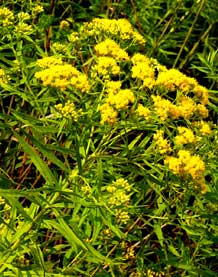Another creature attracted to goldenrods is the praying mantis, the large green
insect famed for eating so many garden pests. The fire chief in our town, who is also a trained entomologist, told me one fall day that the best place to find mantis egg cases is attached to the dead stalks of goldenrod. To prove his point, a few hours later the chief showed up in my office with a dry stalk of goldenrod, mantis eggs attached. I kept the stalk outdoors over the winter and when spring arrived, the mini-mantises hatched and headed out to presumably devour local pests.
Certain goldenrods, as well as steeplebush, are unusual among plants with spikes of flowers in that the blossoms at the top open first and the blooming creeps downward. In most other plants, the bottom-most flowers open and the blooming moves upward. The top-to-bottom flowering of the spike-shaped goldenrods may be connected with their competition for insect attention. When the plant first blooms, many of the late summer flowers are competing to attract bees, and thus the highest, most visible flowers come out first. Later, as the competition fades in the cooling breezes of fall, goldenrod is one of the few flowers left, and it has no trouble flagging down hungry bees with its lower-blooming blossoms.
 Lance-leaved Goldenrod
Lance-leaved Goldenrod